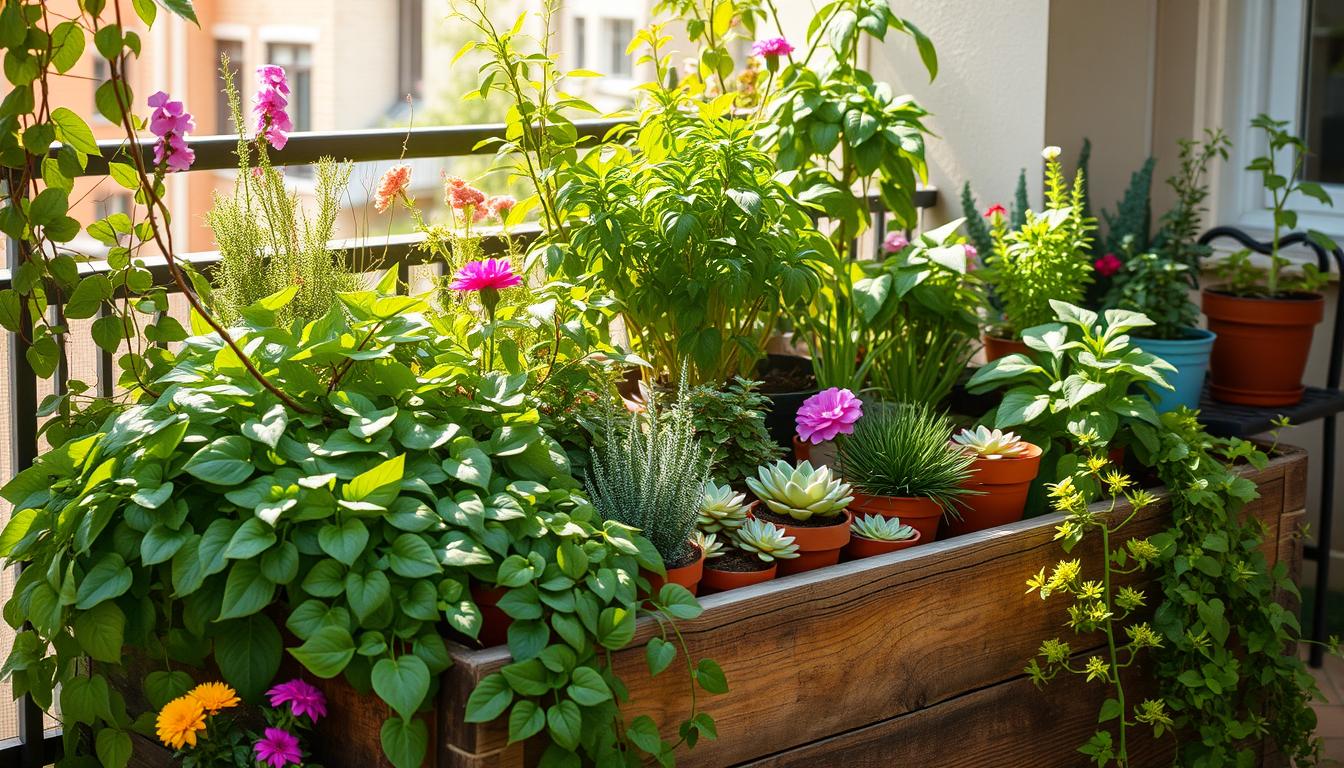Ready to turn your patio, balcony, or windowsill into a lush green space? Welcome to the world of growing plants in pots and vessels! This method has changed home gardening, letting anyone grow plants, no matter their location.
Whether you live in the city with a small balcony or have little yard space, small space gardening is for you. You can grow flowers, herbs, veggies, and even small trees in containers that fit your space.
This method is super flexible. You can move your plants to get the right sunlight, bring them inside when it’s too cold, and try out different setups. Plus, you’ll have fewer weeds and pests than in traditional gardens.
In this guide, we’ll give you tips on picking the best containers, choosing the right plants, and keeping your garden going all year. With a little effort and these tips, you’ll be a pro at growing plants in no time!
Why Container Gardening Is Perfect for Any Space
Container gardening lets anyone grow a garden, no matter where they live. It’s great for those who thought gardening was too hard because of space. You can grow plants on a small balcony or a sunny windowsill.
This method works in many places. It’s perfect for city apartments and homes with bad soil. It’s why so many people choose container gardening.
Benefits for Urban Dwellers and Small Spaces
City living often means no outdoor space. But, container gardening lets city folks connect with nature. Even a tiny balcony or windowsill can become a garden with the right containers.
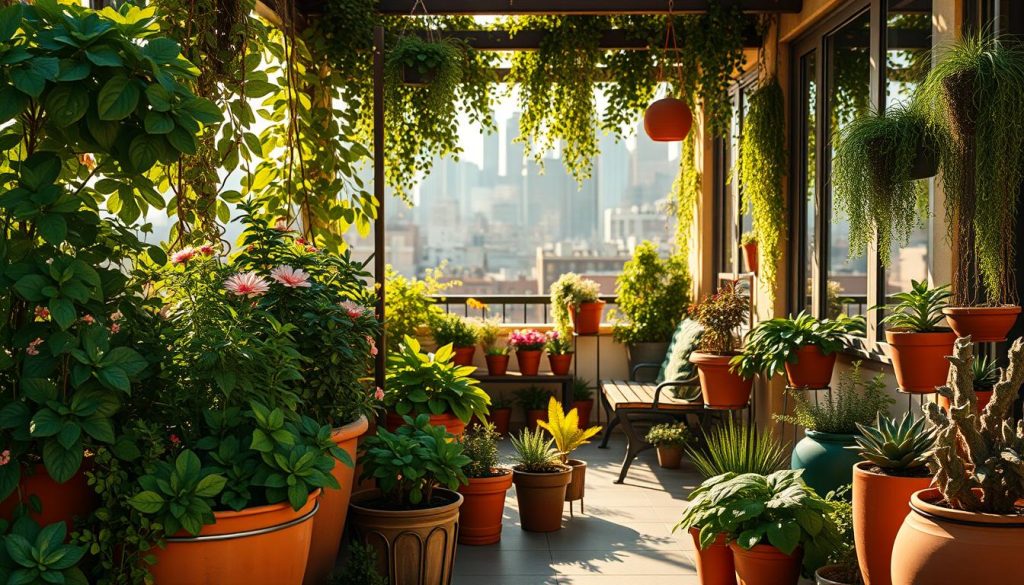
Apartment folks can use wall-mounted planters for vertical gardens. This way, they can grow herbs and veggies and add greenery to their space.
Container gardening in small spaces is more than just pretty. You can grow herbs and veggies right by your kitchen. This makes eating healthy easier and saves money on groceries.
| Urban Space | Container Type | Ideal Plants | Special Benefits |
|---|---|---|---|
| Balcony | Railing planters, medium pots | Herbs, dwarf vegetables | Privacy screen, fresh produce |
| Windowsill | Small pots, window boxes | Herbs, microgreens | Kitchen-adjacent harvesting |
| Indoor space | Decorative pots, hanging baskets | Houseplants, herbs | Air purification, year-round growing |
| Rooftop | Lightweight containers, fabric pots | Sun-loving vegetables, flowers | Full sun exposure, community potential |
Flexibility and Mobility Advantages
Container gardening lets you move plants as needed. Unlike fixed garden beds, potted plants can follow the sun. This ensures they get the best growing conditions all year.
This is super useful during bad weather. You can move plants to safe spots to protect them from frost or heat. This helps your plants grow longer.
For renters, container gardens are a great option. You can take your plants with you when you move. This way, you never have to leave your garden behind.
Container gardening also lets you grow plants that don’t do well in your soil. You can make special soil mixes for plants that need it. This means you can grow more kinds of plants than you thought possible.
Essential Container Gardening Tips for Success
To make your container garden a success, focus on three key things: the right containers, quality soil, and smart watering. These basics help even beginners get great results with little space. Let’s look at the top tips for making your potted plants thrive.
Choosing the Right Containers for Your Plants
Choosing the right containers is crucial for your plants’ health and care. Each material has its own benefits to consider before starting your garden.
Terracotta pots are great for air and water flow but dry out fast and can break in cold. Plastic pots are light, cheap, and keep water well, perfect for plants that love water. Ceramic pots are pretty and keep heat in but are heavy and pricey.
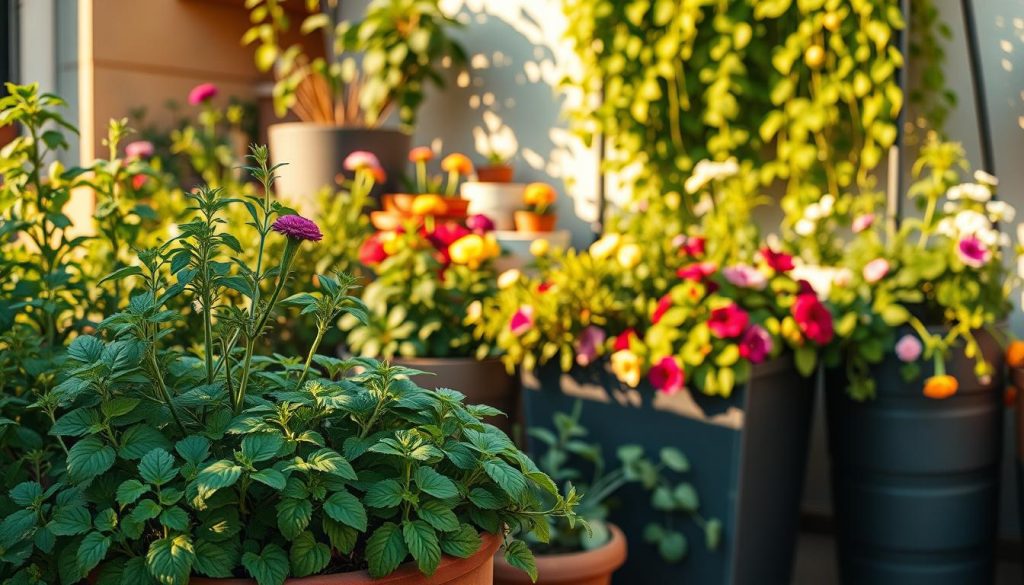
The size of the container is also important. Root veggies need deep pots (at least 12 inches), while herbs with shallow roots do well in 6-inch pots. Make sure the pot has enough room for the plant’s roots and has holes for drainage.
| Container Material | Pros | Cons | Best For |
|---|---|---|---|
| Terracotta | Breathable, natural look, good drainage | Heavy, breakable, dries quickly | Cacti, succulents, Mediterranean herbs |
| Plastic | Lightweight, affordable, retains moisture | Can look cheap, degrades in sunlight | Moisture-loving plants, beginners |
| Ceramic | Decorative, insulating, stable | Heavy, expensive, can crack in frost | Ornamental displays, indoor plants |
| Fabric | Excellent drainage, promotes air pruning | Dries quickly, less decorative | Root vegetables, large plants |
Understanding Potting Soil Requirements
Regular garden soil is too dense for containers and can cause poor drainage and root rot. You need a good potting mix for a successful garden.
The best mix has organic matter for nutrients, perlite or vermiculite for air, and coir or peat moss for water. This mix helps roots grow and prevents waterlogging.
Each plant needs its own soil type. Succulents and cacti need dry, sandy soil, while acid-loving plants like blueberries need peat-based soil. Vegetables prefer rich mixes with compost. If unsure, start with a good all-purpose mix and adjust as needed.
Watering and Drainage Fundamentals
Watering is key to a successful container garden. Potted plants rely on you for water.
Every pot needs drainage holes to avoid root rot. If your pot doesn’t have holes, use a plastic pot inside. Water until you see water coming out of the holes.
The material and size of the container affect how often you need to water. Terracotta and fabric pots dry out faster. Small pots need more water than big ones. Check the soil by sticking your finger in it. If it’s dry, it’s time to water. It’s better to water a little less than too much to avoid root problems.
Selecting the Perfect Plants for Container Gardens
Choosing the right plants is key to a beautiful container garden. Containers have limited space, so plants must adapt well. Even small pots can produce great harvests and look amazing. Let’s look at the best vegetables, herbs, and flowers for your garden.
Best Vegetables for Container Growing
Vegetable container gardening is rewarding with the right picks. Determinate tomatoes like ‘Tiny Tim’ grow well in small spaces. They produce fruit quickly and can fill a 5-gallon pot with up to 10 pounds of tomatoes.
Compact peppers like ‘Redskin’ and ‘Cajun Belle’ do great in 2-3 gallon pots. Bush beans like ‘Mascotte’ and ‘Bush Blue Lake’ need only 12 inches of soil. Leafy greens like ‘Baby Oakleaf’ lettuce and ‘Peppermint’ Swiss chard thrive in shallow containers, offering multiple harvests.
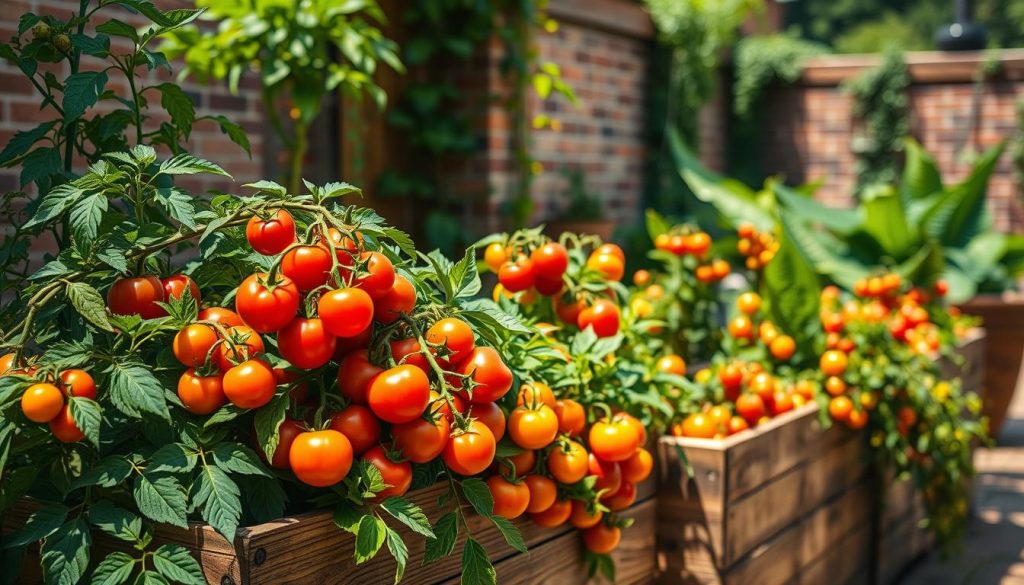
Root vegetables also do well in containers with enough depth. Radishes grow in 30 days in 6-inch pots. Carrots need at least 12 inches of soil. For space-saving, grow vertical crops like cucumbers or peas with a small trellis.
Herbs That Thrive in Pots
Herb container gardens are rewarding and practical. Mediterranean herbs like rosemary, thyme, and sage love dry conditions. They’re great together in the same pot, needing well-draining soil and sun.
Mint is delicious but should be in its own pot because it spreads a lot. A 10-inch pot is enough for mint. Basil is great with tomatoes and grows well in sunny spots. Pinch it back to keep it bushy.
For herbs all year, choose perennials like chives, oregano, and thyme. They need little care and come back every season. Harvest herbs by taking no more than one-third of the plant at once to keep it healthy.
Stunning Flowers for Container Displays
Container gardens shine with the right flowers. Trailing plants like calibrachoa, lobelia, and sweet alyssum cascade over pot edges. They add the “spiller” element to your design.
For height, use “thriller” plants like canna lilies or tall snapdragons. Surround them with “filler” flowers like compact marigolds or petunias. These provide color all season.
When mixing flowers, choose plants that need similar care. Drought-tolerant zinnias and verbena are good together. Moisture-loving impatiens and begonias complement each other. Mix plants with different blooming times for color all season.
Container Garden Design: Creating Visual Impact
Make your container garden stand out with smart design. A well-thought-out garden becomes a highlight that catches the eye. It can turn any space, big or small, into a beautiful part of your home.
The best container gardens mix function with beauty. They create spaces that are good for you and look great. By using simple design ideas, you can make your garden look like it was done by a pro while showing off your style.
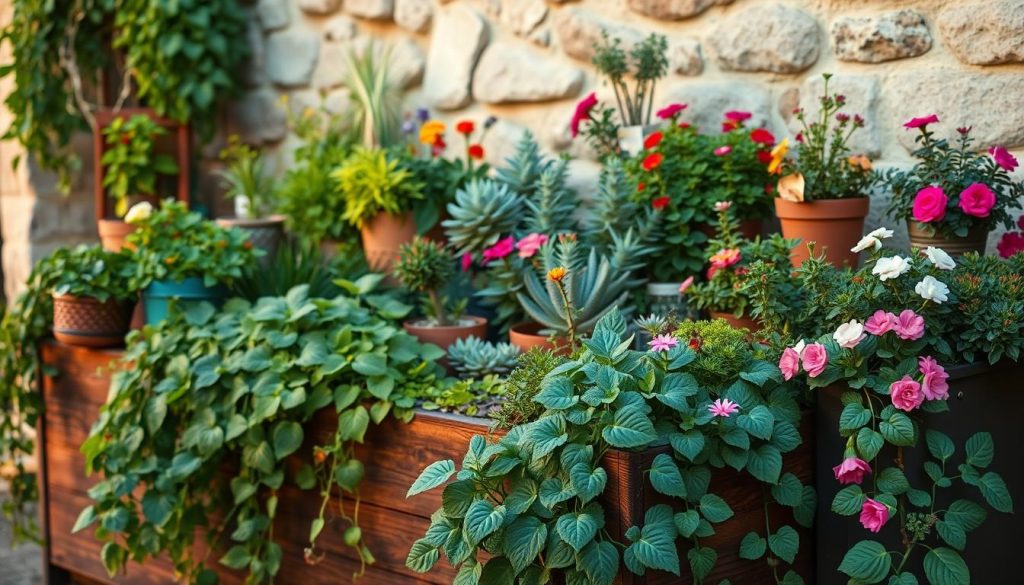
Color Combinations and Arrangements
Color is key in making your container garden pop. Start with color theory basics. Complementary colors make bold contrasts, while analogous colors blend smoothly. For a sleek look, pick one color in different shades.
The “thriller, filler, spiller” method is easy and effective. Put a tall “thriller” plant in the center for a focal point. Then, add “filler” plants for volume and texture. Finish with “spiller” plants that spill over the sides for a soft look.
Vertical Gardening Techniques for Small Spaces
Use vertical gardening to make the most of small spaces. Wall-mounted planters and tiered stands can double your growing area. Turn old items like shoe organizers or ladders into unique vertical gardens.
Trellises help vining plants grow up, making living walls. Place sun-loving plants at the top and shade-tolerant ones below. Use drip irrigation or place moisture-loving plants at the bottom to catch water.
Creating Themed Container Gardens
Themed gardens tell a story and show off your style. A culinary garden might have tomatoes with basil and oregano for pizza sauce. A pollinator garden could have colorful flowers that attract butterflies and bees.
Sensory gardens offer a feast for the senses with fragrant herbs and colorful flowers. Choose containers that fit your theme, like terra cotta for Mediterranean herbs or rustic crates for cottage garden flowers. The container adds to the garden’s beauty.
Seasonal Container Gardening Tips
Understanding each season’s challenges and opportunities is key to year-round container gardening success. Container gardens are not just displays but living systems that change with the weather. By adjusting your care with the seasons, your plants will thrive all year.
Let’s explore how to keep your container garden looking great through the seasons. This includes spring blooms, summer heat, autumn transitions, and winter’s chill.
Spring Container Planting Guide
Spring is the perfect time to refresh your container gardens after winter. Choose cold-hardy spring bloomers like pansies and primroses. Wait until after the last frost to plant tender annuals.
Create layers in your spring containers. Use taller plants like snapdragons in the center. Add mid-height flowers like geraniums and trailing plants like sweet alyssum. For veggies, cool-season crops like lettuce and spinach do well in spring.
Summer Maintenance and Heat Management
Summer brings heat and drought stress to container gardens. Water deeply and consistently, sometimes twice a day during heatwaves. Use morning watering to reduce evaporation.
Apply a 1-2 inch layer of mulch to retain moisture. Keep roots cooler. Position containers for morning sun and afternoon shade.
For vacation care, group containers together. Use self-watering systems or arrange a plant-sitting exchange. Choose heat-loving plants like zinnias and succulents for summer.
Fall and Winter Container Gardening Strategies
As temperatures drop, switch to cold-tolerant plants like ornamental kale and mums. For winter, use evergreens and plants with colorful berries or interesting bark.
Protect container roots from freezing by wrapping pots. Use larger containers in winter for better insulation. For edibles, use cold frames or row covers to extend the growing season.
Year-Round Indoor Container Gardens
Indoor container gardening provides a consistent growing environment. Choose houseplants based on your home’s light levels. Group plants with similar needs together for easier care.
Supplement natural light with grow lights in winter. For edibles, microgreens and compact herbs like basil offer quick harvests. Rotate indoor containers regularly and adjust watering schedules seasonally.
Advanced Techniques for Container Gardening Success
Ready to take your container gardening to the next level? These advanced techniques will make your potted plants stand out. Once you’ve learned the basics, these strategies will help you grow more, save time, and keep your plants healthy. Even with limited space, you can use professional gardening methods to get amazing results.
Companion Planting in Containers
Pairing plants in containers can do more than save space. Some combinations repel pests, improve pollination, or boost growth and flavor. For instance, basil with tomatoes not only saves space but also makes tomatoes taste better and keeps flies away.
Marigolds around vegetable containers can keep aphids off. Nasturtiums are great with cucumbers and squash, attracting pollinators and trapping aphids. In herb containers, rosemary and sage are good together because they need the same water and protect each other from insects.
When planning plant pairs, think about their above-ground space and root depth. Plants with shallow roots can live with deeper-rooted ones without fighting for water or nutrients.
Succession Planting for Continuous Harvests
Why have just one harvest when you can have many? Succession planting means planting seeds or replacing crops to keep production going. It’s perfect for making the most of small spaces.
Start with fast-growing crops like radishes, lettuce, or spinach. Replace them with warm-season veggies like bush beans or compact zucchini as you harvest. Group plants by their water and light needs.
Make a calendar to sow seeds every 2-3 weeks for continuous crops like salad greens. For longer-season veggies, switch from spring crops like peas to fall crops like kale when it gets hot. This keeps your containers productive all season.
Self-Watering Systems and Automation
Consistent watering is key for potted plants, but it can be a chore. Self-watering systems keep moisture steady and save you time. A simple DIY option is a water reservoir – a plastic bottle with holes in it that sits in your soil.
For a more advanced setup, try drip irrigation systems with timers. They deliver water right to the roots, saving water and preventing over or under-watering. Moisture sensors that connect to apps can also monitor soil and alert you when plants need water.
Wicking systems are another low-tech solution. They draw water up from a reservoir below the container, keeping roots moist without drowning them. These systems are great for hot weather or when you’re away, ensuring your garden thrives.
Troubleshooting Common Container Gardening Problems
When your potted plants aren’t doing well, knowing how to fix common problems is key. Container gardens face unique challenges, but most issues have simple solutions. With the right steps, you can keep your garden healthy all year.
Dealing with Pests in Container Gardens
Container gardens often have fewer pests than traditional gardens if managed well. Early detection and quick action are crucial. Common pests include aphids, spider mites, whiteflies, and fungus gnats.
To prevent pests, keep containers well-spaced for better air flow. Regularly check the undersides of leaves and stems. Quarantine new plants for a week to avoid pests.
For organic pest control, use insecticidal soaps or neem oil. Introducing beneficial insects like ladybugs can also help without harsh chemicals.
Preventing and Treating Plant Diseases
Container gardens can be prone to diseases like powdery mildew and root rot. These can harm your plants if not treated.
Poor drainage and overhead watering can lead to disease. Water plants at the base to keep leaves dry. Make sure containers have good drainage holes and consider elevating them.
Clean containers with a 10% bleach solution between plantings. Remove and dispose of infected plants to stop disease spread. Use copper-based fungicides or potassium bicarbonate sprays for organic disease control.
Fixing Nutrient Deficiencies and Soil Issues
Nutrients in container soil deplete faster than in garden beds. Recognizing nutrient deficiencies early is important.
Yellowing leaves often mean a nitrogen shortage. Purple leaves indicate phosphorus issues. Browning edges suggest potassium or salt problems.
Container plants need more fertilizer than garden plants. Use a balanced fertilizer at planting, then liquid fertilizer every 2-4 weeks. Compost tea or fish emulsion are good organic options.
| Problem | Symptoms | Common Causes | Solutions |
|---|---|---|---|
| Wilting Plants | Drooping leaves, dry soil | Underwatering, excessive heat | Water thoroughly, move to shadier location |
| Yellowing Leaves | Yellow leaves, stunted growth | Nutrient deficiency, overwatering | Apply balanced fertilizer, improve drainage |
| Leaf Spots | Brown/black spots on leaves | Fungal disease, water on foliage | Remove affected leaves, water at base only |
| Slow Growth | Minimal new growth, pale color | Root binding, poor soil quality | Repot in larger container, refresh soil |
Container Gardening for Specific Locations
Container gardening is great for many spots around your home. It works well on windy balconies, big patios, or sunny windowsills. Each spot has its own challenges and chances to grow a beautiful garden.
Balcony Container Gardens: Maximizing Limited Space
Balcony gardens need smart planning to beat wind and weight issues. Pick light containers that won’t tip over. Railing planters and vertical systems save space without crowding.
For balcony plants, think about these:
- Compact herbs like basil, thyme, and mint
- Dwarf vegetable varieties such as cherry tomatoes and peppers
- Wind-resistant flowers including petunias and geraniums
- Trailing plants that create visual interest without taking up floor space
Use tall plants to block wind and keep sunlight from being blocked.
Patio and Deck Container Arrangements
Patios and decks have more room and stability for gardening. Use containers to make outdoor areas cozy. Place big containers at corners or entryways to mark the space.
Use different heights of containers to make your patio look interesting. Dwarf trees and grasses in big pots add structure. Small pots with colorful plants add seasonal flair. Group containers by water needs for easier care.
Containers also soften hard areas and connect indoor and outdoor spaces. Put green plants near doors to welcome visitors to your outdoor area.
Window Box and Railing Planters
Window boxes and railing planters are great for small spots. Make sure they’re securely attached to hold the weight of plants and water.
For these spots, pick plants that stay colorful and interesting. Mix upright plants with mounding ones and add trailing plants for a waterfall look.
Window boxes dry out fast. Add water-retaining crystals to the soil and check moisture often, even in cool weather. Self-watering boxes are a good choice for busy gardeners.
Indoor Container Gardening Strategies
Indoor gardening lets you grow plants all year, improving air and decor. First, check the light in different home areas. South windows are best for herbs and flowers, while north windows are good for ferns and peace lilies.
Think about humidity when picking plants. Bathrooms are great for tropical plants, while succulents do well in dry areas. Group plants that like moisture together on trays with water to boost humidity.
Choose containers that match your home’s style but remember to drain well. Use decorative pots with plastic pots inside for easy watering without damaging furniture.
Transform Your Space and Life with Container Gardening
Container gardening is more than just pretty plants. It’s a way to find peace in our fast-paced world. Many people feel less stressed and happier after just 30 minutes with their plants. It’s a chance to slow down and be present.
Even a small balcony can turn into a green oasis with the right tips. Maria in Chicago made her 40-square-foot balcony a garden. It now gives her fresh herbs and tomatoes all summer. In Portland, a community center uses gardens to teach kids about food and make their playground look great.
Every gardener faces problems like plants not doing well or pests. But container gardening is easy to fix. If something goes wrong, you can change it without spending a lot of time or money.
Begin with just one or two pots. Maybe some herbs for your kitchen or flowers for your front steps. As you get more confident, you can add more. The tips we’ve shared will help you succeed, no matter where you are.
Look around your home today. That sunny spot, the empty windowsill, or the bare balcony can all be green spaces. With these tips, you can turn them into lively parts of your home. Your container garden is waiting for you, no perfect conditions needed, just your start.

